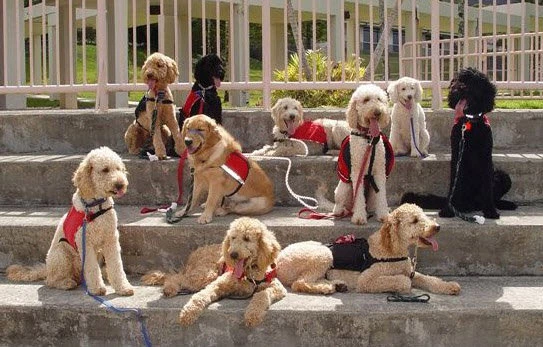
Most of us on this site understand the benefits of a canine companion are numerous. On top of this, many well trained dogs provide professional service to those with physical or mental disabilities. Thanks to the ADA’s ruling in 1990, these service dogs are more than pets and are recognized for their special assistance.
One of the most common questions we get is which dogs are most suitable to be service dogs, and how do they get certified? We’ve got a step-by-step guide for getting a dog service-ready.
For more info, check out this well-reviewed guide to training your own service dog. (Pro tip: it’s currently free on Kindle Unlimited.)
Any breed can make a great service dog but there are some breeds that have the natural instinct to be a working dog. That said, German shepherds, golden retrievers, Labrador retrievers, and border collies are common for a variety of services because of trainability and typical personality. With many physical disabilities a larger dog may be necessary for physical assistance like mobility, but medical alert services or emotional support can be performed by many small breed dogs.
Overall, your dog’s temperament and health are most important. That leads us to step one.
Regular visits to the vet (with regular checkups) is important: health conditions like arthritis and diabetes put an undue strain on the best of pets, so adding service animal responsibilities is unwise.
All service dogs should also be neutered so that males are less aggressive and females don’t face working when in heat. Dogs should be at least 6 months old and past the puppy phase, too.
Like people dogs can be aggressive while others are submissive, and in many cases this isn’t “good” or “bad”— it’s not that simple. The right temperament for a service animal is somewhere in between these to characteristics.If your dog is calm, cool, and collected, but also alert and responsive, chances are she’s a good fit for service work.
As noted above, it can be helpful to know about your dog’s typical breed characteristics. If you have a mixed-breed pooch, a reputable doggy DNA test can help you understand their heritage better.
Some people have the time and spirit to train their service animal, but many of us won’t be up to the task of the in-depth training it takes to have a tested assistance animal. Legally in the United States, there is no required certification, but the service animal training community has come up with self-regulated, minimum standards for training. Search for a reputable trainer near you, you can find our national list of service dog trainers at this link
It is essential to put in the requisite amount of time for training properly. That’s why it’s wisest to use an established trainer.
International standards are a minimum of 120 hours over six months or more—up to 24 in some cases. At least 30 of those hours should be time spent in public dealing with the distractions and potential surprises that come with it.
While the U.S. has no defined requirement, self-regulation is critical and these hours and guidelines are wise to follow. They break down into the following three phases:
It’s time for prime time. Video documentation is always helpful when it’s time to put all that training to the test. Among other things, some basic expectations for a service dog include:
The ADI provides a public access test in PDF form you can download and utilize.
Currently in the United States service dogs are self regulated but need to demonstrated service dog qualities when out in public for access rights. That means we need to be as polite in our public conduct as the dogs we’ve so diligently trained.
Documenting the training process, public access test, and registering with a reputable service like the USA Service Dog Registration will help ensure canine competency and any future situation where your dog (or you) might be questioned.
The ADA has put in great safeguards to protect humans in need of service animals and their pet partners, but having solid answers and evidence in case of misunderstanding or altercation is never going to hurt. If our dogs can go the extra mile, then so can we.
Copyright © 2020 USA Service Dog. All rights reserved.
Aloha I’m Damien but go by Kala or unko by many anywho my dog Maka is Hawaiian for eyes he wants to be of service to me and maybe someone else if I’m going home b4 he goes. Well hope there’s nothing to hard for this journey any advice?